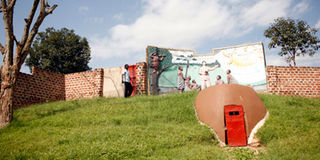The little known cave of Mackay

Outside Mackay’s cave. Except for the colourfully painted wall, nothing seems extraordinary about the site. PHOTOs by Abubaker Lubowa
What you need to know:
The cave, a significant historical structure popularly known as Empuku ya Makayi, looks more like a deserted structure
When you reach the Mackay/Sembera road junction in Nateete, one thing that stands out noticeably is the dominance of the name Mackay. You are welcomed by numerous sign posts: Mackay Memorial College, Mackay Primary School, Mackay Kindergarten, Martyr’s Church, Natete and Mackay’s Cave.
The cave, a seemingly insignificant structure popularly known as Empuku ya Makayi, looks more like a deserted structure. Except for the colourfully painted wall above, two winged angels blowing trumpets on either side of Jesus Christ in one corner, a white man in a hat dressed in Kkaki with a bible in hand preaching to attentive listeners in the centre, and in the other corner, a man on a tree as if on the lookout, nothing seems extraordinary about the site.
Amazingly, this spot is where the roots of Christianity and formal education were planted by missionary Alexander Mackay.
On his arrival, Mackay met the Kabaka at his palace on Lubaga Hill where he was given a place to stay. But later, he was sent to Nateete after the Kabaka learnt that he was using a binocular to view the palace. This annoyed the Kabaka, who ordered for his transfer to Nateete, the place where a church ( Martyrs Church, Nateete) is currently located.
Mackay started establishing his quarters. Later on in 1879, he assembled the first printing press in Uganda and printed the gospel of St Mathew. The wooden Albion hand-proofing printing press, which is today displayed at the ethnographic section of the Uganda museum, was used to print materials which he used to teach Christianity, reading and writing. He also translated the gospel of Matthew into Luganda. His stool, which he could sit on while teaching, is still available in the church.
How the cave came about
After the death of Kabaka Mutesa I, an event that ushered into the era of Kabaka Mwanga, the relationship between the kingdom and missionary went sour.
In responce to this, Mackay dug a cave at a distance of 150 metres below his quarters where he would hide to teach Christianity and formal education. Just below the cave is a spring dug by Mackay. This is where he could fetch water and was also a source of water for the surrounding villages as he watched over them from the wall engraving.
The well also acted as a bait, with which he used to persuade people into Christianity. The cave was purposefully dug facing the well to enable him talk to people who would come to fetch water. He would persuade them to enter the cave so he could teach them Christianity and formal education.
“In fact, they would pretend to have come for water yet they had come for classes,” says Rev Samuel Kalibbala, the current reverend at Martyrs Church, Nateete.
Security
Just outside the cave stands a tall tree which would be used to spy on whether there was any religious persecutor coming. Inside the cave, there were two tunnels; one would lead him to his uphill quarters, while the second led to a nearby village. This was an escape route since Mackay anticipated danger resulting from deteriorating relationship between Buganda Kingdom and Christians.
Kalibbala says the cave worked as a missionary house and it is where Mackay translated the gospel according to St Mathew into Luganda. “The cave is where civilisation in Uganda began from. The first converts were baptised in this place. Carpentry and joinery also started from here,” Kalibbala adds.
Richard Ngombe, in his 50s whose grandfather’s house was 60 metres away from Mackay’s quarters, says, the latter told him that the cave was a protestant church. It is also the foundation of martyrdom.
His achievements
Mackay was not only keen on winning more souls for God, he also put in long hours teaching his new converts new skills such as building roads, houses, machinery, and boats as well as reading and writing.
According to Rev Samuel Kalibbala, the current reverend at Martyrs Church, Nateete, Mackay came with three main ideas; education, Christianity and health, which he saw as interwoven aspects.
He made the architectural plan for Martyrs Church. His original keys are still the ones used for the church. The doors on the church were also made by Mackay.
The church was dedicated to three martyred Christians; Makku Kakumbi, Yusufu Lugalama and Nuwa Sserwanga, who were picked from the place where Martyrs church is located and at Busega Mpima Erebera on orders of Mwanga II. As a church, they always commemorate their death.




